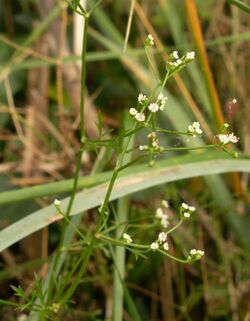Biology:Petroselinum
| Petroselinum | |
|---|---|

| |
| Petroselinum segetum, France | |
| Scientific classification | |
| Kingdom: | Plantae |
| Clade: | Tracheophytes |
| Clade: | Angiosperms |
| Clade: | Eudicots |
| Clade: | Asterids |
| Order: | Apiales |
| Family: | Apiaceae |
| Subfamily: | Apioideae |
| Tribe: | Apieae |
| Genus: | Petroselinum Hill |
| Species | |
| |
Petroselinum is a genus of two parsley species of flowering plants in the family Apiaceae, native to western and southern Europe and northern Africa.[1]
Plants of this genus are bright green, hairless, biennial and herbaceous; they are rarely annual plants. In the first year, they form a rosette of pinnate to tripinnate leaves and a tap root used as a food store over the winter. In the second year they grow a flowering stem up to 1 m tall with sparser leaves and umbels of white or pinkish to yellowish-green flowers.[2][3]
Taxonomy
The generic name comes from rendering the Greek word πετροσέλινον petroselinon "rock-celery" into Latin,[4][5] from πέτρα petra "rock, stone"[6] and σέλινον selinon "celery".[7][1][3] Mycenaean Greek se-ri-no, in Linear B, is the earliest attested form of the word selinon.[8]
Species
The species of this genus are:
- Petroselinum crispum (garden parsley) from southern Europe and northern Africa (southern Italy, Greece, Algeria, Tunisia). It is an important culinary herb, widely used for flavouring and as a vegetable.
- Petroselinum segetum (corn parsley) from western Europe (Great Britain and the Netherlands south through France to Italy, Spain and Portugal). It is edible with a similar flavour like garden parsley, but it is not widely cultivated. It occurs in grassland, hedgerows, and river banks. In Great Britain, it is confined to lowland regions in southern and central England and southern Wales, and is scarce and declining due to agricultural intensification.[2] It has narrower, more lanceolate leaves than garden parsley, only single pinnate, not tripinnate.[3]
References
- ↑ 1.0 1.1 The Euro+Med Plantbase Project: Petroselinum
- ↑ 2.0 2.1 Blamey, M. & Grey-Wilson, C. (1989). Illustrated Flora of Britain and Northern Europe. ISBN:0-340-40170-2
- ↑ 3.0 3.1 3.2 Interactive Flora of NW Europe: Petroselinum species list[yes|permanent dead link|dead link}}] and genus description[yes|permanent dead link|dead link}}]
- ↑ Lewis, Charlton T.; Short, Charles (1879). "petrŏsĕlīnon (-īnum )". petrŏsĕlīnon (-īnum ). Perseus Digital Library. https://www.perseus.tufts.edu/hopper/text?doc=Perseus:text:1999.04.0059:entry=petroselinon.
- ↑ Liddell, Henry George; Scott, Robert (1940). "πετροσέλινον". A Greek-English Lexicon. Perseus Digital Library. https://www.perseus.tufts.edu/hopper/text?doc=Perseus:text:1999.04.0057:entry=petrose/linon.
- ↑ Liddell, Henry George; Scott, Robert (1940). "πέτρα". A Greek-English Lexicon. Perseus Digital Library. https://www.perseus.tufts.edu/hopper/text?doc=Perseus:text:1999.04.0057:entry=pe/tra.
- ↑ Liddell, Henry George; Scott, Robert (1940). "σέλινον". A Greek-English Lexicon. Perseus Digital Library. https://www.perseus.tufts.edu/hopper/text?doc=Perseus:text:1999.04.0057:entry=se/linon.
- ↑ "Palaeolexicon". Palaeolexicon. http://www.palaeolexicon.com/ShowWord.aspx?Id=16927.
Wikidata ☰ Q310933 entry
 |

